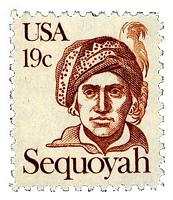
• CherokeeDictionary: Cherokee-English dictionary & data base
• Glosbe: Cherokee-English dictionary
• Manataka: Cherokee-English dictionary by topics
• Cherokee Nation: Cherokee-English vocabulary by topics
• Cherokee words for body parts: human body
• Trees
• Plants
• Animals
• Birds
→ Cherokee keyboard to type the characters of the Tsalagi script
→ conversion Tsalagi <> Latin script
• The Cherokee nation and its language by Margaret Peake Raymond (2008)
• The typographic inception of the Cherokee sillabary by Patrick Giasson (2004)
• The Cherokee syllabary from script to print by Ellen Cushman, in Ethnohistory (2010)
• Cherokee writing reexamined: a linguistic analysis of the Cherokee syllabary, by Melissa Klein, dissertation (2019)
• Sequoyah, innovative creator of the Cherokee syllabary, Georgia Historical Society (2017)
• A reference grammar of Oklahoma Cherokee by Brad Montgomery-Anderson (2008)
• Cherokee grammar by Durbin Feeling (1975)
• Handbook of the Cherokee verbs by Durbin Feeling, Craig Kopris, Jordan Lachler, Charles van Tuyl (2003)
• Tone and accent in Oklahoma Cherokee by Hiroto Uchihara, thesis (2013)
The Cherokee language is today mainly spoken in the state of Oklahoma. It belongs to the Iroquian family.
The Cherokee use a syllabary invented in 1821 by Sequoyah.
Tha Austrian botanist Stephan Endlicher used the name sequoia, for the first time in his book, Synopsis coniferarum (1847), to designate the tree widely distributed in California, often named redwood.
Sequoyah : ᏎᏉᏯ

• Literature of the Cherokees by George Foster (1889)
• Story of the Cherokee Bible (1899)
• The Swimmer manuscript: Cherokee sacred formulas and medicinal prescriptions, by James Mooney, revised and completed by Frans Olbrechts (1932)
• The sacred formulas of the Cherokees by James Mooney (1891)
• Gateway: translation of the New Testament into Cherokee, American Bible Society (1860)
• Cherokee New Testament in Cherokee (Tsalagi & Latin scripts) & English
• The New Testament translated into Cherokee, by Samuel Worcester & Elias Boudinot (1860)
• The shorter catechism translated into Cherokee, by Amory Chamberlin (1892)
• Cherokee hymns (1909)
• Cherokee hymn book by Samuel Worcester & Elias Boudinot (1896)
• The Cherokee singing book (1846)
• Boston Athenæum: books in Cherokee language
• Library of Congres: Cherokee phoenix, ᏣᎳᎩ ᏧᎴᎯᏌᏅᎯ (1828-1829) first Native American newspaper
ᏂᎦᏓ ᎠᏂᏴᏫ ᏂᎨᎫᏓᎸᎾ ᎠᎴ ᎤᏂᏠᏱ ᎤᎾᏕᎿ ᏚᏳᎧᏛ ᎨᏒᎢ.
ᎨᏥᏁᎳ ᎤᎾᏓᏅᏖᏗ ᎠᎴ ᎤᏃᏟᏍᏗ ᎠᎴ ᏌᏊ ᎨᏒ ᏧᏂᎸᏫᏍᏓᏁᏗ ᎠᎾᏟᏅᏢ ᎠᏓᏅᏙ ᎬᏗ.
• About the Nation: culture & history
• The Cherokee country: map
• The shifting map of Cherokee land use practices in Indian territory by James Parins, in Elohi (2012)
• Reclaiming a story: recasting the Cherokee image through melodramatic narrative, by Eddie Glenn, in Activist media and biopolitics (2012)
• European trade goods at Cherokee settlements in Southwestern North Carolina, by Chris Rodning, in North Carolina archaeology (2010)
• Cherokee households and communities in the English contact period (1670-1740), by Jon Marcoux, dissertation (2008)
• History of the Cherokee Indians and their legends and folk lore, by Emmet Starr (1921)
• Myths of the Cherokee by James Mooney (1902)
• The Cherokee river cult by James Mooney, in The Journal of American folk-lore (1900)
• The Cherokee ball play, in The American anthropologist (1890)
• Se-quo-yah, the American Cadmus and modern Moses: a complete biography of the greatest of Redmen, around whose wonderful life has been woven the manners, customs and beliefs of the early Cherokees, by George Foster (1885)
→ United States: maps & documents